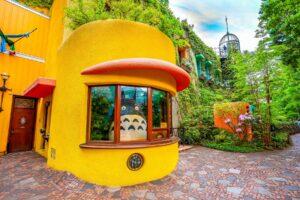Fodor's Expert Review Shitamachi Museum
Japanese society in the days of the Tokugawa shoguns was rigidly stratified. Some 80% of the city's land was allotted to the warrior class, temples, and shrines. The remaining 20%—between Ieyasu's fortifications on the west, and the Sumida-gawa on the east—was known as Shitamachi, or "downtown" or the "lower town" (as it expanded, it came to include what today constitutes the Chuo, Taito, Sumida, and Koto wards). It was here that the common, hardworking, free-spending folk, who made up more than half the population, lived. The Shitamachi Museum preserves and exhibits what remained of that way of life as late as 1940.
The two main displays on the first floor are a merchant house and a tenement, intact with all their furnishings. This is a hands-on museum: you can take your shoes off and step up into the rooms. On the second floor are displays of toys, tools, and utensils donated, in most cases, by people who had grown up with them and used them all their lives. There are also... READ MORE
Japanese society in the days of the Tokugawa shoguns was rigidly stratified. Some 80% of the city's land was allotted to the warrior class, temples, and shrines. The remaining 20%—between Ieyasu's fortifications on the west, and the Sumida-gawa on the east—was known as Shitamachi, or "downtown" or the "lower town" (as it expanded, it came to include what today constitutes the Chuo, Taito, Sumida, and Koto wards). It was here that the common, hardworking, free-spending folk, who made up more than half the population, lived. The Shitamachi Museum preserves and exhibits what remained of that way of life as late as 1940.
The two main displays on the first floor are a merchant house and a tenement, intact with all their furnishings. This is a hands-on museum: you can take your shoes off and step up into the rooms. On the second floor are displays of toys, tools, and utensils donated, in most cases, by people who had grown up with them and used them all their lives. There are also photographs and video documentaries of craftspeople at work. Occasionally various traditional skills are demonstrated, and you're welcome to take part. This small but engaging museum makes great use of its space, and there are volunteer English-speaking guides.
READ LESS








